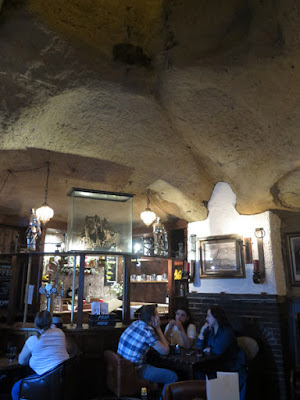 |
| A view east along the nave |
When exploring the exterior of St. Peter’s church in Nottingham city centre, I took good note of the various stones that have been used in its fabric over the years but, once inside, the remnants of a lime based covering had obscured the stonework to the extent that I really didn’t notice the stone itself; however, looking closely at the photographs, yellow to red colour tones can be distinguished in the sandstone.
 |
| A view west along the nave |
Looking mostly at the structure instead, both of the walls to the south and north aisles are plastered and painted, as is the Victorian chancel, and it is only the walls at each end of the nave, with their respective arches, and the arcades that have exposed stonework.
 |
| The south arcade |
The 5 bay south arcade dates to the C13 and is constructed with arches that are Early English in style, but is quite unusual in that the second and third arches from the west end are separated by a small section of wall and not a column. On the plan of the church by the architect D.A. Marshall, this is marked as having a C12 core and the oldest part of the original church, which was destroyed by the Empress Matilda in 1140.
 |
| A capital with stiff leaf carving |
Some of the capitals are ornamented with stiff leaf carvings, which is a feature of the Early English style, and there are several carved heads; however, many of these intricate carvings have lost their detail and, judging by their sharp profiles, some of the heads may be replicas.
 |
| A change in the style of masonry above the south arcade |
Looking at the masonry above the south arcade, although the colours of the stone can barely be seen, the change in the shape and size of the blocks shows that there has been a phase of rebuilding, which includes the C15 clerestory – where the window tracery is in a late Perpendicular Gothic style.
 |
| The north arcade |
Turning around to examine the C14 north arcade, where the columns are much taller, the capitals were modified in 1495 with a castellated design and, having been damaged during the English Civil Wars in 1644, the clerestory was renewed in 1699 with very simple windows.
 |
| An old roof line above the tower arch |
At the west end of the nave, the C15 tower has a very tall arch and above this there is a very distinct old roof line, which clearly shows the very asymmetrical design of the nave, with the north aisle being constructed inside the old wall instead of the outside, which is the usual practice.
 |
| Wall memorials in the chancel |
In the north aisle and the chancel, there are numerous wall memorials that are made of a wide variety of decorative stones, with elaborate monuments to the Locke family, and there are also several war memorials – including the St. James’ war memorial, which I particularly liked.
 |
| The St. James' war memorial |
























































